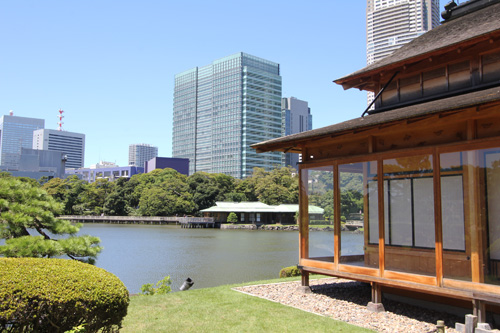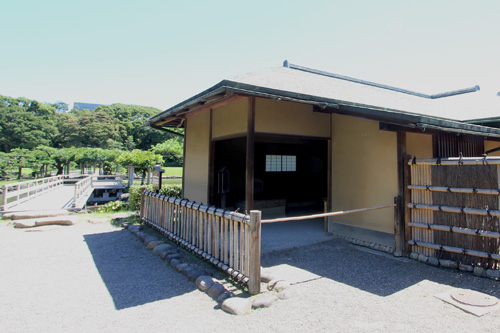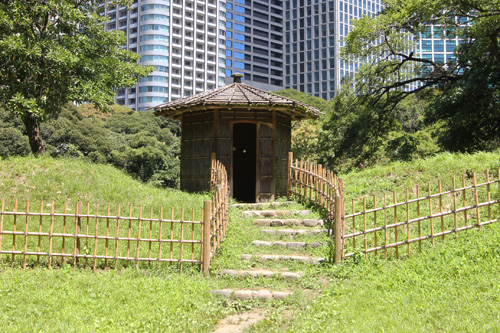The Parts of Hamarikyu
- Published 2015.7.28

Otemon Bridge ("Main Gate") and Naka-no-gomon gate ("Inner Gate"): Entrances to the Hama-rikyu Gardens. The Otemon Bridge is the main northern entrance while the Naka-no-gomon Bridge is the north-western gate.
Enryo-kan: Enryo-kan was Japan`s first western-style stone building and was built on the grounds of the Hama Detached Palace. The building was originally made to be a naval academy for the Tokugawa Shogunate but was later modified to serve as lodgings for foreign dignitaries. It housed esteemed individuals such as Prince Alfred (second son of Queen Victoria), King Kalakua of Hawaii (first reigning monarch to visit Japan), and Ulysses S. Grant (18th president of the United States) from 1869 until 1883. It was later demolished in 1890 because of its age. Recently the Tokyo government announced that it plans to recreate the first state guest house ahead of the 2020 Summer Olympics in Tokyo.
Umite-Chaya (Teahouse): This site was built as a rest house for boat cruising and to observe fishing by Lenobu, 6th Tokugawa Tycoon at 1707. It was also used as the base for court noble and women of the Edo castle. The name of "Umite Chaya" was derived from that they could get the finest view of the sea from the tea house. It was burnt down due to the Kantou Great Earthquake on September 1st, 1923.

Nakajima-no-ochya (Assembly hall or Tea House of Inner Island): A tea house that is built on a small island surrounded by the water of the Shiori-no-ike tidal pond. It also serves cold or hot matcha green tea with mocha.
Matsu-no-ochaya: This tea house burnt down in the Great Kanto Earthquake and World War II. It was recently restored in 2010.
Taka-no-chaya: This tea house burnt down in the Great Kanto Earthquake and World War II. It is currently being restored and will be completed in 2017.
Konoji-shima (Konoji Islets): The name "Konoji" meants "the Chinese character of 'Õ░Å' (meaning small)". The islets are given the name "Konoji" because their arrangements in the pond resemble the shape of the character, with a main islet in the center and two smaller ones linked to it by a bridge respectively on its left and right sides.
Shioiri-no-ike (Seawater Tidal Pond): The pond takes in seawater, so its water level goes up and down with the tide. The garden is a typical daimyo garden that features a central pond, Shioiri-no-ike (28,000 m^2). Mullets, young sea bass, gobies, eels, crabs, shrimp, Redfin, and Biringo inhabit the pond. Lots of wild ducks and black-headed gulls fly over to Hamarikyu in the autumn and winter.
Otsutai-bashi Bridge: This bridge was first built by the sixth shogun, Tokugawa Lenobu when he carried out great repairs of the garden in 1707. Even though the bridge itself and its appearance have changed with the times, the elegance of the reflection of the bridge and Nakajima Teahouse on the surface of the pond has become even greater than before. It is still the center of the garden landscape until present day. The bridge is about 118 meters long and is made entirely out of wood.
Sluice gate (floodgate): The flowing in and out of the sea water has been regulated by the weir from olden times. The weir is indispensable to Shiori-no-ike Pond, as it brings changes to the garden`s atmosphere through the adjustment of the water level of the pond to the ebb and flow of the tide of Tokyo Bay.
Water-bus landing: The Hamarikyu Gardens are accessible by the water-bus transit system which connects out to Tokyo Bay. If entering the park from the water-bus, the entrance fee must be paid (\300)

Koshin-do Kamoba and Shinsen-za Kamoba (Wild duck hunting site): Kamoba (meaning "duck hunting ground") was once a facility for hunting waterfowl, especially wild ducks for fun, built in the villa grounds of the feudal lords in the past. It is said that the facility of kamoba can be seen only in five places nationwide at present and one of them is Hamarikyu Gardens. The Kamoba is comprised of motodamari, a big pond with islets in the middle for the waterfowl that come flying over to rest, and several hikibori, watercourses dug from the edge of the pond. To start with, some decoy domestic ducks, which have been trained to lure the game waterfowl into a watercourse, are released into the pond. The pond is surrounded by an embankment about three meters in height and it is planted heavily with bamboo grass, bamboos and evergreens so that a relaxing environment for the waterfowl to sense that no one is around can be created. Next, from the ohnozoki, a lookout from where people can look out over the pond, the condition of the waterfowl gather and the direction of the wind are checked, and at the same time, which watercourse to use is determined. Then, at the konozoki, a structure built at the end of a watercourse where lookouts hide, people scatter feed while hitting wooden planks. Finally the waterfowl that have been lured into the chosen watercourse by the feed and the decoys are ambushed by the falcons and the people with nets hidden in the shade of the watercourse embankments.
